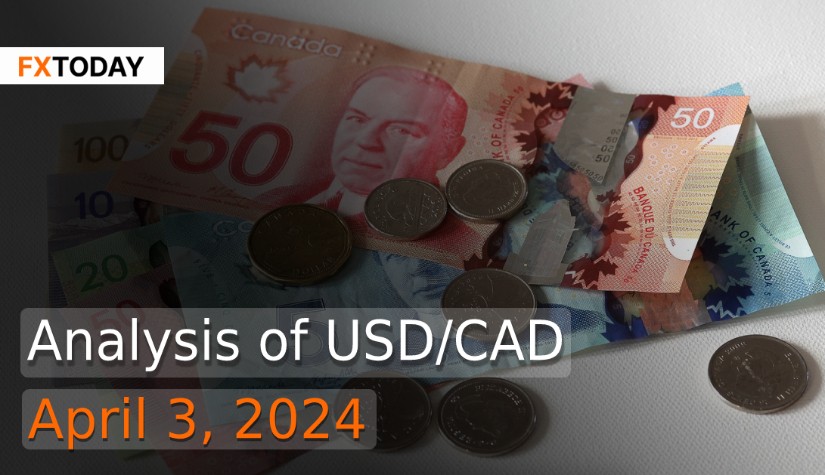Canada's Economic Growth Surpasses Expectations
Canada's economy showed robust growth in January, surpassing expectations and indicating a promising start to the year. Statistics Canada reported a 0.6% expansion, the highest rate in a year, driven by various sectors such as education services, benefiting from the resolution of public sector strikes in Quebec. Notably, real estate and rental sectors continued their upward trend for the third consecutive month. Services-producing industries grew by 0.7%, while goods-producing industries expanded by 0.2%.
Preliminary estimates for February suggest another positive trend, with a projected growth of 0.4%, primarily led by mining, quarrying, and oil and gas extraction industries. Inflation in Canada eased unexpectedly to 2.8% in February, the slowest pace since June. This data mitigates pressure on the Bank of Canada (BoC) to implement an early interest rate cut.
Recent economic indicators show signs of improvement in Canadian manufacturing and wholesale trade. Factory sales are expected to have risen by 0.7% in February, primarily driven by the petroleum and coal subsector. Similarly, wholesale trade likely increased by 0.8%, with notable gains in machinery, equipment, motor vehicles, and parts. However, retail sales contracted slightly in January due to lower goods prices and reduced sales of motor vehicles and parts.
The BoC emphasizes the urgent need for businesses to increase investment to enhance productivity and mitigate inflationary pressures. The recent BoC survey indicates improved sentiment among Canadian firms, with fewer anticipating a recession or expecting inflation to exceed 3% in the next two years.
Although market dynamics remain uncertain from recent inflation and GDP data, uncertainty remains regarding the impact of sustained high interest rates on the economy. This shift in expectations has led to reduced speculation about an imminent rate cut in June. Factors such as sluggish wage growth, albeit at relatively high levels, and declining labor shortages are considered by the BoC in its assessment. A separate survey reflecting consumer expectations suggests a prevailing belief among Canadians that inflation has slowed, with no anticipation of further rate hikes in the near term.
To address the housing affordability crisis, Prime Minister Justin Trudeau announced a C$6 billion Canada Housing Infrastructure Fund aimed at accelerating housing construction and upgrades. High inflation and interest rates have contributed to soaring property prices and rents, exacerbating the housing shortage, which has become a significant political issue.
The BoC's upcoming rate announcement on April 10 will coincide with the release of new projections. Economists anticipate that the BoC might act sooner on rate cuts compared to the U.S. Federal Reserve, given Canada's tepid economic growth and cooling inflation. They also caution that Canada's economy is particularly sensitive to interest rates due to high household debt levels, the highest among G7 countries.
The U.S. dollar experienced a decline on Tuesday following its recent peak, reaching the highest level in nearly five months. This decrease came after the release of a report indicating that U.S. job openings remained stable at elevated levels throughout February.
Meanwhile, the U.S. manufacturing sector witnessed growth for the first time in 1-1/2 years in March, with a notable rebound in production and increased new orders. However, factory employment remained subdued amid notable layoff activity and upward pressure on input prices. The Institute for Supply Management's (ISM) survey suggested a positive trend in the sector's recovery, albeit with lingering risks from escalating raw material prices.
Despite the manufacturing rebound signaling potential growth for the economy, concerns over possible goods inflation resurgence persist, particularly given the surge in raw material prices, potentially delaying the Federal Reserve's anticipated rate cut. Fed Chair Jerome Powell emphasized a cautious approach on Friday to lowering borrowing costs despite slight increases in inflation measures. Consequently, it is anticipated that the USD/CAD currency pair will maintain stability in the upper range, driven by comparable returns between the two countries. Despite this, there could still be a slight trend of the US dollar strengthening further during this period.
Data for Technical Analysis (1H) CFD USD/CAD
Resistance : 1.3574, 1.3576, 1.3578
Support : 1.3570, 1.3568, 1.3566
1H Outlook
Source: TradingView
Buy/Long 1 If the support at the price range 1.3565 - 1.3570 is touched, but the support at 1.3570 cannot be broken, the TP may be set around 1.3575 and the SL around 1.3563, or up to the risk appetite.
Buy/Long 2 If the resistance can be broken at the price range of 1.3574 - 1.3579, TP may be set around 1.3584 and SL around 1.3568, or up to the risk appetite.
Sell/Short 1 If the resistance at the price range 1.3574 - 1.3579 is touched, but the resistance 1.3574 cannot be broken, the TP may be set around 1.3569 and the SL around 1.3581, or up to the risk appetite.
Sell/Short 2 If the support can be broken at the price range of 1.3565 - 1.3570, TP may be set around 1.3558 and SL around 1.3576, or up to the risk appetite.
Pivot Points Apr 3, 2024 02:25AM GMT
|
Name
|
S3
|
S2
|
S1
|
Pivot Points
|
R1
|
R2
|
R3
|
|---|---|---|---|---|---|---|---|
| Classic | 1.3563 | 1.3566 | 1.3569 | 1.3572 | 1.3575 | 1.3578 | 1.3582 |
| Fibonacci | 1.3566 | 1.3568 | 1.357 | 1.3572 | 1.3574 | 1.3576 | 1.3578 |
| Camarilla | 1.357 | 1.3571 | 1.3571 | 1.3572 | 1.3573 | 1.3573 | 1.3574 |
| Woodie's | 1.3563 | 1.3566 | 1.3569 | 1.3572 | 1.3575 | 1.3578 | 1.3582 |
| DeMark's | - | - | 1.357 | 1.3573 | 1.3576 | - | - |
Sources: Investing 1, Investing 2
















